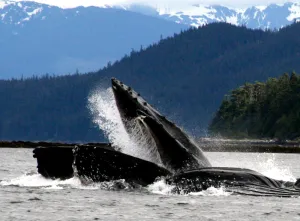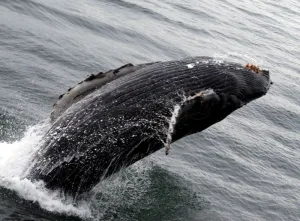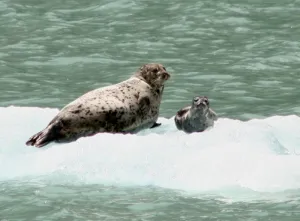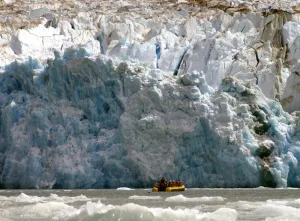Exploring Alaska’s Glacier Country by Small Ship

The underwater microphone beneath our skiff picked up the whoosh of bubbles and the sound of whales chattering like children at recess. But we knew the humpbacks circling under us were on serious business—the pursuit of dinner.
As if at a conductor’s signal, all sound from the hydrophone ceased and Pavarotti began his solo. We had to call him Pavarotti. The whale’s ululating song rose from the depths in a crescendo as moving as any operatic finale. When he fell silent we tensed, eyes trained on the water. Suddenly, with a roar like a bursting dam, eight 35-ton whales erupted from the surface, their enormous mouths open wide, scooping up thousands of herring. Then they sank back into the sea.
In our inflatable boat, the clicking of cameras died and a dozen voices rose in excited babble–not unlike the whales’ chatter. Then we settled down to watch for dark, shiny humps to break the surface, and the flash of massive white flukes as the whales dived. Sounding (diving) is the prelude to “bubble-netting,†a feeding tactic that is peculiar to humpbacks in Alaska and along the west coast of the Americas. The whales herd herring into a cone of bubbles, force them to the surface and . . . dinner is served.
Time and again we heard Pavarotti’s enchanting song and watched the water explode in a mass of bodies that rocked our sturdy boat. We felt the sea spray, heard the long sigh of a “blow,†and smelled the fishy exhalations issuing from the whales’ blowholes. Our ears became attuned to the long sighing sound of a “blow.†And still we lingered, until the cold and growling stomachs sent us to the comforts of our ship, the Safari Explorer.
Pavarotti was the star of day three in our week-long voyage in Alaska’s Glacier Bay National Park, the world’s largest protected marine sanctuary. Lured by the prospect of extraordinary scenery and wildlife encounters, my friend and I had flown cross-country to Juneau, where we boarded the Explorer with 25 other passengers from the U.S. and Great Britain. We ranged in age from 11 to 80, with the majority in their 50s and 60s.

The Ship
Launched in May 2008, the 145-foot, 36-passenger Safari Explorer is the newest and largest of four luxury yachts belonging to Un-Cruise. Guests occupy 18 staterooms, all with large windows, sliding glass doors, DVD players and private baths with heated tile floors. Common areas include a dining area lined with large windows; a library; a lounge with a large screen TV for movies and naturalist presentations; an open bar stocked with premium liquors and fine wines; and a large sun deck with a sauna, hot tub and exercise equipment. The spacious, glass-fronted bridge is always open to guests.
The Crew
On the dock, the ship’s 18-member crew, dressed in crisp whites, lined up to greet us. By the following morning they knew every guest’s first name and drink preferences. With a passenger-crew ratio of two-to-one, it was obvious that shameless spoiling was de rigueur. Fortunately, it was service without servitude, a comfortable interaction among guests and crew. Any staff member was always the “right person†to fulfill a request, whether it was for an extra pillow in a cabin or a round of Bloody Marys for the hot tub. Crew members filled in empty seats in skiffs or kayaks, sharing adventures with us. Two personable naturalists were our expedition leaders, entertaining us with informal briefings on what to look for in each region we explored. The licensed masseuse on board led morning yoga classes and dispensed complimentary massages.

The Itinerary
Most vessels are allowed less than a day in Glacier Bay National Park, America’s 3.3-million-acre wilderness crown jewel. The Explorer holds a coveted two-day permit, so we were able to overnight in the park and venture into seldom-visited regions before moving on to southern Alaska highlights such as Frederick Sound, Windham Bay and Endicott Arm. The ship anchored overnight in remote coves and traveled during the day to give us maximum exposure to scenery and wildlife.
As we eased into Glacier Bay National Park and picked up a resident park ranger who would be our park guru, we fell under the spell of the natural sanctuary. Glacier Bay is the homeland of the indigenous Hoonah Tlingit people, who were displaced when the park became a national monument in 1925. In recent years they’ve been allowed to resume some traditional activities in the park and convey the Tlingit heritage to their youngsters.
Traveling north, the steel-hulled ship began bumping through a field of icebergs. Off to each side were ice floes laden with mother seals and their newborns, their pale faces and big, soft eyes staring back at us. In the uppermost reaches of the bay, the Explorer was dwarfed by enormous glaciers, their blue-tinted faces towering hundreds of feet above the water and stretching to the horizon. We often took to the kayaks for a closer look, picking our way among the floes and watching 200-year-old sheets of ice “calve†from the glacier and tumble into the bay.
Critter encounters were the order of the day—every day—roly-poly, bewhiskered sea lions popping up within 10 feet of our skiffs and kayaks; tufted puffins and other seabirds chasing a nest-robbing raven; cormorants doing kamikaze dives for dinner; mountain goats gamboling across sheer cliffs with no visible footholds; and bald eagles snatching fat salmon from the water with the ease of an office worker at a vending machine. Occasionally, we spotted black and brown (grizzly) bears browsing on the shoreline.

And, every day, the scenery vied with that of the day before. Hills clothed in deep green conifers against a backdrop of snow-covered mountains. Naked cliffs in every imaginable earth tone rising like skyscrapers from the water. Waterfalls cascading down rock faces, following centuries-old grooves. Wisps of fog dancing around small islands decorated with gnarled trees. Sometimes we stretched our “land legs†on hikes through pristine woods and rainforests replete with unusual plants, or climbed cliffs to gaze down on the ship.
Rarely did we catch sight of other ships or signs of habitation onshore. Instead, we enjoyed a splendid isolation, an antithetical combination of luxury and wilderness. That’s why it felt strange on day five to walk the streets of Petersburg, a small Norwegian fishing village. While the ship took on water and fresh seafood everyone checked e-mail and made cell phone calls for the first time since our departure.

That evening we dined on a massive white king salmon pulled from the icy waters that morning. Like every meal before it, this one was beautifully prepared by the Explorer chef, who offered us fresh seafood entrees daily along with meat choices such as pork loin, leg of lamb or steak. The chef and his staff were also remarkable for their good-natured flexibility. The meal schedule was always a moving target. If critters appeared, the ship slowed or stopped. If kayakers chose to wait for a glacier to calve or linger in the shallows over brilliantly-hued starfish, the next meal was simply put on hold.
All too soon, we sat down to our final dinner aboard, a spectacular feast of filet mignon and Alaskan king crab legs followed by Bananas Foster prepared tableside. The evening’s entertainment was a slide show of our voyage composed by the crew, followed by a musical tribute by the four youngsters on board that mentioned every crew member. Back in our cabins, we found that the Explorer crew had taken one last opportunity to spoil us. Each of us had a DVD of the slide show, along with the day-by-day itinerary and contact information for passengers and crew.
Juneau
To allow for the vagaries of air travel and allow time to explore Juneau, most passengers had booked an extra day before and after the voyage. It was easy to fill every minute. Juneau has a lot to offer, including the Alaska State Museum, with its 23,000 artifacts, works of art and natural history exhibits; an underground tour of the AJ Gold Mine; the Chez Alaska Cooking School; a bird’s-eye view of the rainforest with Alaska Zipline Adventures; the Mt. Roberts Tram, which travels to a peak 1,800 feet above the city; the Macaulay Salmon Hatchery; and the Cycle Alaska Bike and Brew Tour, a bicycling excursion to Auke Lake and the Mendenhall Glacier that concludes with a beer tasting session at the Alaskan Brewing Company. There are also fishing excursions, bear-watching tours to Admiralty Island, helicopter flights to dogsled on a glacial ice-field, and floatplane sightseeing flights. Juneau is a port of call for large cruise ships, so its streets are lined with shops and restaurants to suit any budget.
WHEN YOU GO
Un-Cruise (un-cruise.com, 1-888-815-5428) Safari Explorer is one of the company’s four luxury yachts that cruise Alaska, Mexico’s Sea of Cortez, the Pacific Northwest and the Columbia/Snake rivers. The Explorer’s seven-night Glacier Country cruise (roundtrip from Juneau) is offered May-September. The fare includes all transfers and shore excursions, unlimited premium wine and spirits, gourmet meals, one massage, and a pre- and post-trip hospitality suite.

Resources
Alaska — www.travelalaska.com
Juneau – www.traveljuneau.com
Published in Global Traveler
